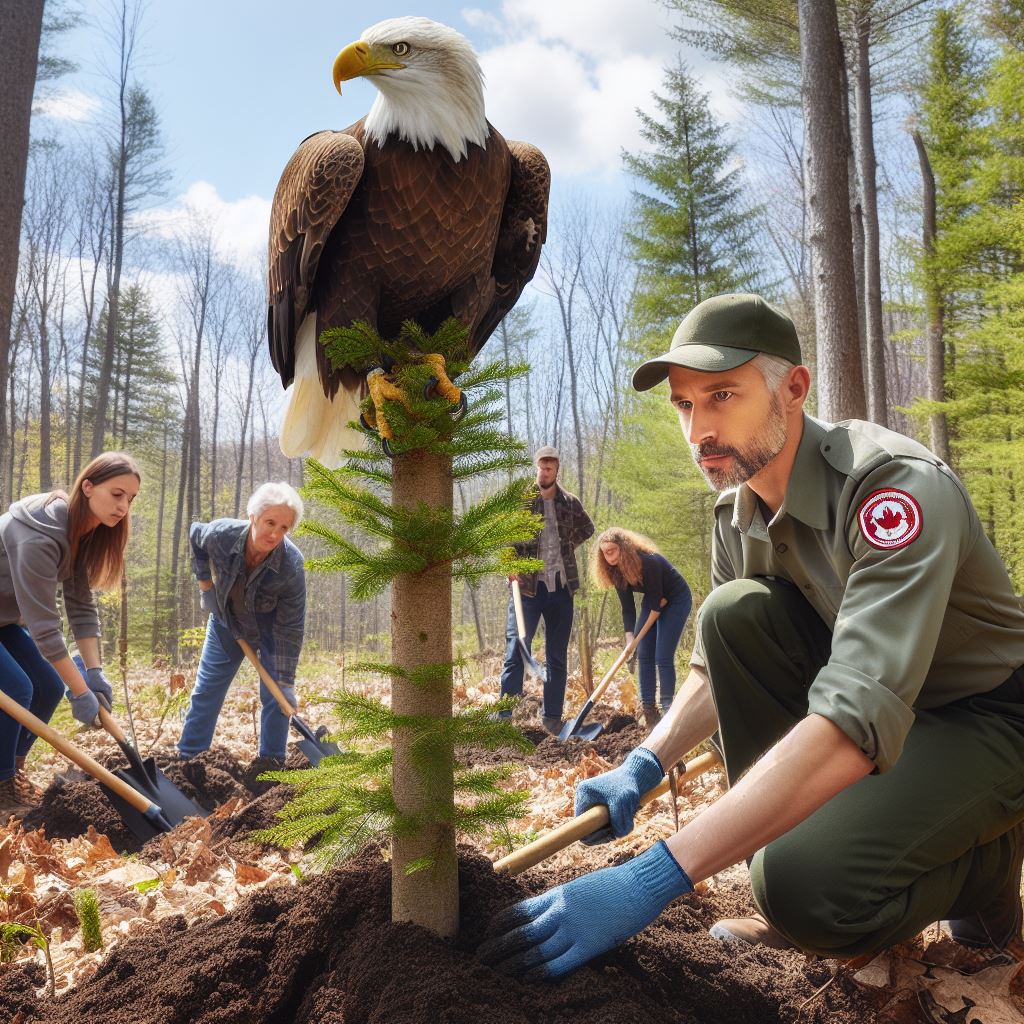Introduction
Canada’s wildlife is a treasure trove of species, ranging from majestic moose to playful otters.
It is essential to protect and preserve these animals and their habitats for future generations.
Conservation organizations, such as the Canadian Wildlife Federation, are actively engaged in wildlife preservation.
Scientists in Canada conduct insightful research to better understand wildlife behavior and ecology.
The focus of this blog post will be to explore the various initiatives and projects dedicated to wildlife conservation.
By highlighting these efforts, we hope to raise awareness and promote a greater appreciation for Canadian wildlife.
This post will delve into the importance of sustainable management practices and habitat restoration initiatives.
Furthermore, we will discuss the challenges faced in protecting Canadian wildlife and propose potential solutions.
Through collaborative efforts and public involvement, Canadian wildlife can have a brighter, more secure future.
Join us on this exciting journey as we uncover the fascinating world of Canadian wildlife conservation and scientific endeavors.
Importance of Canadian wildlife conservation
Highlighting the rich biodiversity in Canada
Canada is home to a vast array of wildlife species, making it one of the most biodiverse countries in the world.
The country’s diverse ecosystems support a wide range of flora and fauna, including iconic species like the polar bear, moose, and bald eagle.
Protecting Canadian wildlife ensures the preservation of this rich biodiversity for future generations to enjoy.
The significance of Canadian wildlife for ecosystems and overall environmental health
Wildlife plays a crucial role in maintaining healthy ecosystems by contributing to various ecological processes.
Many species act as pollinators, helping to fertilize plants and ensure their survival.
Predators help control the population of prey species, preventing overgrazing and maintaining a balanced ecosystem.
By conserving Canadian wildlife, we safeguard the natural processes that sustain the environment and support human well-being.
Economic importance of wildlife tourism and recreational activities
Canadian wildlife attracts millions of visitors each year, generating significant revenue for the country.
Tourists come to experience the beauty and diversity of the Canadian wilderness, contributing to the local economy.
Wildlife-based tourism provides employment opportunities, particularly in rural and remote areas.
Furthermore, recreational activities such as bird-watching, hiking, and fishing rely on the presence of thriving wildlife populations.
Preserving Canadian wildlife not only benefits the environment but also boosts the economy and supports local communities.
In essence, Canadian wildlife conservation is of utmost importance due to its rich biodiversity and its role in maintaining healthy ecosystems.
Moreover, wildlife-related tourism and recreational activities contribute significantly to the country’s economy.
By protecting and preserving Canadian wildlife, we ensure the survival of diverse species, maintain ecological balance, and promote sustainable economic growth.
Unlock Your Career Potential
Visualize a clear path to success with our tailored Career Consulting service. Personalized insights in just 1-3 days.
Get StartedCurrent challenges and threats to Canadian wildlife
Habitat loss and fragmentation
Canadian wildlife faces numerous challenges and threats that require urgent conservation and science efforts.
Habitat loss and fragmentation due to urbanization, deforestation, and industrial development are major concerns.
These activities destroy natural habitats and disrupt ecosystems, pushing many wildlife species to the brink of extinction.
Climate change and its impact on wildlife populations
Climate change exacerbates the challenges faced by Canadian wildlife. Rising temperatures have profound effects on ecosystems, altering the distribution and abundance of species.
For sensitive Arctic species like polar bears, seals, and Arctic birds, melting ice poses a significant threat to their survival.
Pollution and chemical contamination
Pollution and chemical contamination further endanger wildlife populations. Industrial pollutants contaminate air, water, and soil, exposing animals to toxic substances.
Chemicals like pesticides accumulate in the food chain, affecting animals at higher trophic levels. This contamination weakens immune systems, making wildlife more vulnerable to diseases.
Overhunting and poaching
Overhunting and poaching are illegal activities that pose a severe threat to Canadian wildlife. Species that are overharvested for commercial purposes may face population declines and even extinction.
Unregulated hunting practices also disrupt predator-prey relationships and upset ecosystem balances.
To address these challenges, Canadian wildlife conservation efforts focus on several strategies.
Protecting and restoring habitats through land conservation initiatives and promoting sustainable land-use practices are crucial steps.
Reducing greenhouse gas emissions and mitigating climate change impacts safeguard wildlife from further habitat disruption.
Regulating the use and disposal of pollutants and chemicals is vital to prevent contamination and protect wildlife health.
Additionally, enforcing strict laws and penalties against overhunting and poaching help preserve species and maintain ecosystem stability.
Collaboration between government agencies, conservation organizations, scientists, and local communities is key to the success of Canadian wildlife conservation.
Research efforts contribute to understanding the specific threats faced by different species and guide targeted conservation actions.
Overall, addressing the current challenges and threats to Canadian wildlife requires a comprehensive and multi-faceted approach.
Only through collective efforts can the rich biodiversity of Canada’s wildlife be safeguarded for future generations.
Governmental and non-governmental organizations involved in wildlife conservation
Overview of governmental initiatives and legislation
- The Canadian government has taken significant steps to protect and conserve wildlife.
- Several federal laws and regulations aim to prevent the extinction of species and maintain biodiversity.
- The Species at Risk Act (SARA) identifies and protects endangered and threatened species across the country.
- The Migratory Birds Convention Act safeguards migratory birds and their habitats.
- The Fisheries Act ensures the conservation and sustainable use of aquatic resources and habitats.
- The National Parks Act establishes national parks and reserves to protect wildlife and wilderness.
- The Canadian Environmental Assessment Act evaluates potential impacts on wildlife during development projects.
- The government collaborates with Indigenous communities, researchers, and stakeholders for effective conservation measures.
Role of Parks Canada in protecting wildlife and their habitats
- Parks Canada is a key governmental organization responsible for conserving wildlife and ecosystems
. - It manages national parks, marine conservation areas, and historic sites across Canada.
- Parks Canada ensures conservation through research, monitoring, and protective measures.
- It works with Indigenous communities to integrate traditional knowledge in conservation efforts.
- The organization focuses on preserving biodiversity, habitat restoration, and endangered species recovery.
- Parks Canada promotes public engagement and education to raise awareness about wildlife conservation.
- It collaborates with other organizations and stakeholders to implement effective conservation strategies.
- The agency employs scientists, park wardens, and conservation officers to enforce regulations and protect wildlife.
- Parks Canada’s efforts contribute to maintaining ecological integrity, promoting sustainable tourism, and providing recreational opportunities.
Introduction to key non-profit organizations working towards conservation efforts
- Several non-profit organizations in Canada play a significant role in wildlife conservation.
- The World Wildlife Fund (WWF) Canada works to protect wildlife, forests, freshwater resources, and oceans.
- The Nature Conservancy of Canada focuses on conserving ecologically significant lands and endangered species.
- Ducks Unlimited Canada specializes in wetland conservation and habitat restoration for waterfowl.
- Wildlife Preservation Canada aims to prevent the extinction of endangered species through captive breeding and reintroduction programs.
- Bird Studies Canada conducts research and monitoring to conserve bird populations and their habitats.
- The Canadian Wildlife Federation promotes wildlife-friendly practices, habitat conservation, and environmental education.
- Wildlife Habitat Canada funds projects for enhancing wildlife habitat and increasing public awareness.
- The Nature Trust of British Columbia protects ecologically important lands in the province.
- Raincoast Conservation Foundation works towards protecting wildlife and their habitats in coastal British Columbia.
- These non-profit organizations rely on public support, donations, and partnerships for their conservation efforts.
In general, both governmental and non-governmental organizations in Canada are actively involved in wildlife conservation.
The Canadian government has established various initiatives, laws, and regulations to protect wildlife and their habitats.
Parks Canada, as a key governmental organization, plays a vital role in managing national parks and implementing conservation measures.
Non-profit organizations, such as WWF Canada, the Nature Conservancy of Canada, and Wildlife Preservation Canada, contribute significantly to wildlife conservation through research, habitat protection, and public engagement.
With collaborative efforts from all these organizations, Canada continues to prioritize the preservation of its diverse wildlife species and ecosystems.
Read: Canadian Biologists: Pioneers in Research

Research and scientific contributions in Canadian wildlife conservation
Highlighting the work of scientific institutions and academic researchers
Scientific institutions and academic researchers play a vital role in Canadian wildlife conservation efforts.
Through their studies and fieldwork, they contribute valuable knowledge and insights into preserving and protecting the country’s diverse wildlife.
- Canadian Wildlife Research and Conservation Initiative: This initiative brings together various scientific institutions across Canada to collaborate on wildlife research and conservation projects. Their work includes studying endangered species, monitoring population trends, and identifying conservation strategies.
- Academic research: Universities and research institutes in Canada dedicate significant resources to wildlife conservation research. They conduct studies to understand the ecology and behavior of various species, as well as the impacts of human activities on their habitats.
- Collaborative partnerships: Scientific institutions often collaborate with government agencies, Indigenous communities, and non-profit organizations to enhance their research efforts and ensure scientific findings translate into effective conservation actions.
Research projects focused on understanding wildlife behaviors, population dynamics, and habitat requirements
To effectively conserve Canadian wildlife, researchers undertake projects specifically designed to understand various aspects of wildlife behavior, population dynamics, and habitat requirements.
- Behavioral studies: Researchers conduct observations and experiments to understand how wildlife behaves in different environments. By studying feeding habits, breeding patterns, and migration behaviors, scientists can develop conservation strategies that promote healthy populations.
- Population dynamics: Understanding population sizes, demographics, and reproductive rates is crucial for effective wildlife conservation. Researchers use advanced statistical models to gather data and assess the health and stability of different wildlife populations.
- Habitat requirements: Research projects focus on identifying the specific habitat requirements of different species. This includes studying preferred vegetation types, nesting conditions, and the impact of habitat loss on wildlife populations.
The use of technology, such as tracking devices and DNA analysis, in wildlife conservation research
Advancements in technology have revolutionized wildlife conservation research in Canada, enabling scientists to gather data more efficiently and investigate critical aspects of species’ lives.
- Tracking devices: Researchers use GPS tracking devices and satellite telemetry to monitor migratory patterns, assess habitat use, and track the movements of individual animals. This information helps identify essential areas for conservation and understand species’ responses to environmental changes.
- DNA analysis: Genetic analysis techniques, including DNA barcoding and population genomics, provide valuable insights into species identification, genetic diversity, and population connectivity. This data aids in wildlife management decisions and the conservation of vulnerable populations.
- Remote sensing: Satellite imagery and aerial surveys allow researchers to monitor large-scale changes in habitats, detect illegal activities, and assess the impacts of climate change on ecosystems. This information guides conservation planning and resource allocation.
In fact, research and scientific contributions are integral to Canadian wildlife conservation.
The work of scientific institutions, academic researchers, and the use of technology enhance our understanding of wildlife ecology, behavior, and conservation needs.
This knowledge forms the foundation for effective conservation strategies and ensures the long-term survival of the country’s diverse wildlife.
Read: Top Canadian Universities for Aspiring Biologists
Uncover the Details: Networking in the Environmental Science Field
Success stories and conservation efforts in specific Canadian regions or species
Restoration of the Vancouver Island marmot population
The Vancouver Island marmot, a rare and endangered species, has seen a remarkable recovery in recent years.
Conservationists have been working tirelessly to restore their population, which had dwindled to only 30 individuals in the early 2000s.
Through captive breeding and reintroduction programs, the numbers have steadily increased to over 200 marmots today.
These efforts have involved collaboration between various organizations, government agencies, and even local communities.
The success of this initiative showcases the power of concerted conservation efforts in preserving endangered species.
Efforts to protect the endangered North Atlantic right whale
The North Atlantic right whale is one of the most endangered large whale species in the world.
Conservation efforts have been focused on preventing entanglement in fishing gear and reducing ship strikes.
New regulations have been implemented to enforce vessel speed limits and establish shipping lanes to minimize collisions.
Furthermore, initiatives have been undertaken to work with the fishing industry to develop whale-friendly gear and practices.
While the population remains critically endangered, these proactive measures are crucial steps toward their recovery.
Conservation initiatives in the boreal forests and their impact on wildlife populations
The vast boreal forests of Canada are home to numerous wildlife species, making their conservation of utmost importance.
Sustainable forestry practices, such as certified logging and protected areas, have been implemented to conserve habitat.
Efforts also focus on maintaining connectivity between forested regions to ensure the viability of wildlife populations.
Additionally, research and monitoring programs aid in understanding species dynamics and identifying conservation priorities.
These efforts play a vital role in safeguarding wildlife and maintaining the ecological integrity of the boreal forests.
Generally, specific Canadian regions and species have witnessed success stories and conservation efforts.
The restoration of the Vancouver Island marmot population, protection of the North Atlantic right whale, and conservation initiatives in the boreal forests serve as shining examples.
These achievements highlight the importance of collaboration, proactive measures, and sustainable practices in preserving Canadian wildlife.
However, continuous efforts and ongoing support are necessary to ensure the long-term survival and thriving of these species and ecosystems.
Read: Day in the Life of a Canadian Biologist: An Overview
Delve into the Subject: Famous Canadian Environmental Scientists’ Stories
Opportunities for individuals to contribute to wildlife conservation in Canada
Volunteering with conservation organizations
Volunteering with local conservation organizations is a meaningful way to actively contribute to wildlife conservation efforts in Canada.
These organizations rely on dedicated volunteers to assist in various tasks such as habitat restoration, wildlife monitoring, and community education programs.
Becoming a volunteer allows individuals to directly participate in hands-on conservation work, gaining knowledge and skills while making a tangible difference in protecting Canadian wildlife.
Whether it’s joining a tree planting initiative or assisting in animal rescue operations, every contribution counts towards preserving and restoring the natural environment.
Citizen science initiatives and reporting wildlife observations
Citizen science initiatives provide opportunities for individuals to actively engage in wildlife conservation by contributing data and observations.
Many initiatives encourage people to report their wildlife sightings or participate in monitoring programs to gather valuable information about species population and distribution trends.
By participating in citizen science initiatives, individuals become valuable contributors to scientific research and conservation efforts.
Their observations help researchers and conservationists gain a better understanding of wildlife ecology, behavior, and the impact of human activities on species and their habitats.
Supporting wildlife-friendly policies through advocacy and public awareness
Advocacy and raising public awareness are crucial in shaping wildlife-friendly policies in Canada.
By actively supporting and promoting initiatives and campaigns focused on conservation, individuals can contribute to the development of policies that protect and conserve wildlife and their habitats.
Through various advocacy means, such as writing to policymakers, signing petitions, or participating in public meetings, individuals can voice their concerns and opinions about wildlife and habitat conservation.
By engaging in public awareness initiatives, individuals can also educate others about the importance of wildlife conservation and inspire action within their communities.
Additionally, supporting wildlife-friendly policies requires individuals to make environmentally conscious choices in their daily lives, such as consuming sustainably sourced products, reducing waste, and minimizing their carbon footprint.
These personal choices can collectively have a significant positive impact on wildlife conservation efforts.
Essentially, individuals have various opportunities to actively contribute to wildlife conservation in Canada.
Through volunteering, citizen science initiatives, and advocacy efforts, everyone can play a crucial role in protecting and preserving the rich biodiversity of Canadian wildlife.
Read: Salary Range for Biologists in Canada: 2024 Update
Uncover the Details: The Future of Lab Tech Careers in Canada Explored
Conclusion
Recap of the main points discussed in the blog post
The Canadian wildlife is diverse and unique, comprising various species that face numerous threats.
Conservation efforts have been crucial in protecting endangered animals and preserving their habitats.
Scientific research plays a vital role in understanding wildlife and implementing effective conservation strategies.
Collaborative efforts between government organizations, scientists, and the public have been instrumental in conservation success.
Reinforcement of the importance of Canadian wildlife conservation
Conserving Canadian wildlife is not just about protecting our rich natural heritage but also maintaining ecological balance.
By preserving wildlife, we ensure the sustainability of ecosystems, which directly impact human well-being.
Preserving biodiversity contributes to economic growth, promotes tourism, and enhances the overall quality of life.
Call-to-action for readers to get involved and support conservation efforts
Every individual can contribute to wildlife conservation by adopting sustainable practices like reducing waste and supporting local initiatives.
Volunteering or donating to wildlife organizations helps fund research, habitat restoration, and conservation programs.
It is essential to spread awareness about the importance of wildlife conservation and inspire others to take action.
Together, we can protect Canadian wildlife for future generations and ensure a harmonious coexistence with nature.




